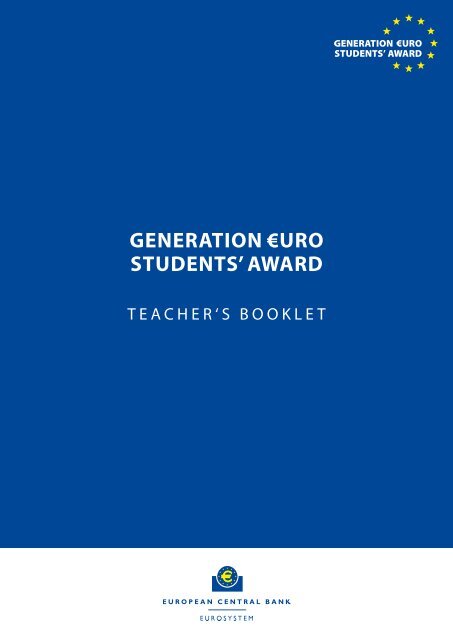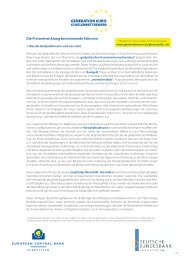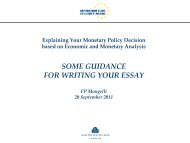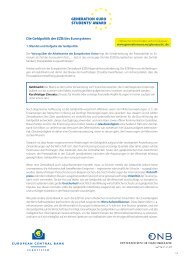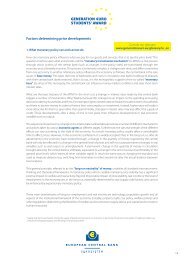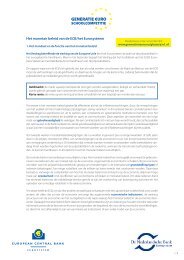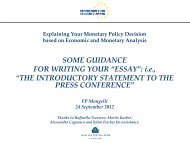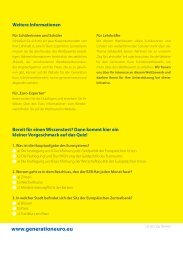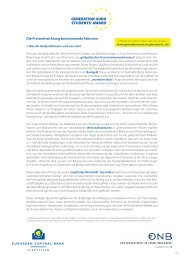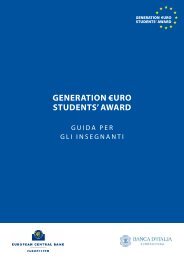Teacher's booklet - the Generation ?uro Students' Award
Teacher's booklet - the Generation ?uro Students' Award
Teacher's booklet - the Generation ?uro Students' Award
You also want an ePaper? Increase the reach of your titles
YUMPU automatically turns print PDFs into web optimized ePapers that Google loves.
<strong>Generation</strong> €<strong>uro</strong><br />
Students’ <strong>Award</strong><br />
Teacher‘s <strong>booklet</strong>
Index<br />
FOREWORD<br />
<strong>Generation</strong> €<strong>uro</strong> Students’ <strong>Award</strong> 4<br />
– Objective 4<br />
– Overview 4<br />
– Participants 4<br />
– Rounds 4<br />
1. Teachers 5<br />
– Your role 5<br />
– Resources 5<br />
2. Rounds 5<br />
– Online quiz 5<br />
– Essay 5<br />
– Presentation 6<br />
– Question and answer session 6<br />
3. Composition of <strong>the</strong> jury 7<br />
4. Assessment criteria 7<br />
5. Prizes 7<br />
6. E<strong>uro</strong>pean award event 7<br />
7. Privacy statement 7<br />
Annex: Introduction to central banking and<br />
monetary policy within <strong>the</strong> e<strong>uro</strong> area 8<br />
It is a great pleasure for me to introduce <strong>the</strong> <strong>Generation</strong> €<strong>uro</strong> Students’ <strong>Award</strong>, which<br />
aims to familiarise students with macroeconomic concepts and monetary policymaking.<br />
This is <strong>the</strong> first time that <strong>the</strong> E<strong>uro</strong>system, comprising <strong>the</strong> E<strong>uro</strong>pean Central Bank<br />
(ECB) and <strong>the</strong> national central banks of <strong>the</strong> e<strong>uro</strong> area, has organised such a competition,<br />
which will be launched simultaneously in <strong>the</strong> e<strong>uro</strong> area countries.<br />
The initiative gives <strong>the</strong> “e<strong>uro</strong> generation” – <strong>the</strong> first generation to have grown up with<br />
<strong>the</strong> e<strong>uro</strong> – an opportunity to learn about <strong>the</strong> key part that monetary policy plays in <strong>the</strong><br />
single currency and in price stability. In its policy-making, <strong>the</strong> ECB’s Governing Council<br />
focuses on keeping prices stable for <strong>the</strong> 332 million fellow citizens in <strong>the</strong> e<strong>uro</strong> area<br />
today. We believe that <strong>the</strong> competition will offer students an insight into <strong>the</strong> workings<br />
of <strong>the</strong> economy and <strong>the</strong> role of <strong>the</strong> ECB and <strong>the</strong> E<strong>uro</strong>system.<br />
As a teacher, you will make an essential contribution to <strong>the</strong> competition. We are relying on you to guide your students<br />
through <strong>the</strong> competition rounds and help <strong>the</strong>m understand monetary policy-making. This will require some preparation,<br />
so we have put toge<strong>the</strong>r <strong>the</strong> necessary information for this task. You can find it in this <strong>booklet</strong> or on <strong>the</strong> competition website,<br />
www.generatione<strong>uro</strong>.eu.<br />
I hope that you and your students will enjoy participating in <strong>the</strong> competition and I wish you <strong>the</strong> best of luck. The ECB<br />
Executive Board is looking forward to meeting you at <strong>the</strong> E<strong>uro</strong>pean award event in Frankfurt am Main.<br />
1 September 2011, Frankfurt am Main<br />
Schedule 12<br />
Contacts at <strong>the</strong> ECB 12<br />
2 3
<strong>Generation</strong> €<strong>uro</strong><br />
Students’ <strong>Award</strong><br />
1. Teachers<br />
2. Rounds<br />
Objective<br />
Your role<br />
Round 1: online quiz<br />
The <strong>Generation</strong> €<strong>uro</strong> Students’ <strong>Award</strong> aims to help secondary<br />
school students understand monetary policy and how<br />
it relates to <strong>the</strong> economy as a whole. They will gain an insight<br />
into <strong>the</strong> role of a central bank by learning about <strong>the</strong> function<br />
of monetary policy instruments, in particular interest rate<br />
decisions, and by using some of <strong>the</strong> data available to <strong>the</strong><br />
Governing Council of <strong>the</strong> E<strong>uro</strong>pean Central Bank (ECB)<br />
each month. The competition should also raise students’<br />
awareness of <strong>the</strong> E<strong>uro</strong>system and deepen <strong>the</strong>ir knowledge<br />
of <strong>the</strong> world of finance.<br />
Overview<br />
The competition consists of three rounds and will end with<br />
a E<strong>uro</strong>pean award event at <strong>the</strong> ECB in Frankfurt am Main.<br />
Participants<br />
The competition is aimed at students aged 16 to 19 who live<br />
in a e<strong>uro</strong> area country. Their ages may vary slightly from<br />
country to country (depending on <strong>the</strong> national education<br />
system), but <strong>the</strong>y should be in <strong>the</strong>ir final years of secondary<br />
education. All students are entitled to take part, irrespective<br />
of what <strong>the</strong>y are studying.<br />
Students will be required to form teams of five and to<br />
nominate a teacher to accompany <strong>the</strong>m. Each team should<br />
come from <strong>the</strong> same school, with <strong>the</strong> teachers and students<br />
<strong>the</strong>mselves deciding on membership. Each team should<br />
also nominate one of its members as team leader. The<br />
teacher should work at <strong>the</strong> school taking part in <strong>the</strong><br />
competition and teach at least one member of <strong>the</strong> team.<br />
The composition of <strong>the</strong> team should not be changed<br />
during <strong>the</strong> competition unless extraordinary circumstances,<br />
such as illness, prevent this.<br />
Rounds<br />
Round 1. Online quiz: <strong>the</strong> quiz consists of three levels –<br />
beginners, intermediate and expert – with a total of<br />
30 questions. Students must answer <strong>the</strong> questions as a<br />
team. The teams with <strong>the</strong> best scores will be invited to<br />
participate in <strong>the</strong> second round (essay round).<br />
Round 2. Essay: in this round, teachers have to actively<br />
coach <strong>the</strong>ir students. Each team will be asked to assess <strong>the</strong><br />
economic conditions in <strong>the</strong> e<strong>uro</strong> area and <strong>the</strong> inflation<br />
outlook on <strong>the</strong> basis of some of <strong>the</strong> data available to <strong>the</strong><br />
Governing Council of <strong>the</strong> ECB. Teams should make an<br />
assessment and <strong>the</strong>n decide on <strong>the</strong> level at which to set<br />
<strong>the</strong> key interest rate. They will need to explain <strong>the</strong>ir<br />
decision in an essay of no more than 2,000 words. The<br />
essays must be uploaded to <strong>the</strong> <strong>Generation</strong> €<strong>uro</strong> website<br />
(www.generatione<strong>uro</strong>.eu).<br />
Round 3. Presentation: in this round, five of <strong>the</strong> best<br />
teams from <strong>the</strong> essay round will be invited to give a<br />
presentation on <strong>the</strong>ir interest rate decision to a jury of<br />
experts, who will <strong>the</strong>n choose <strong>the</strong> winning team. In both <strong>the</strong><br />
essay and <strong>the</strong> presentation, <strong>the</strong> interest rate decision should<br />
reflect <strong>the</strong> economic circumstances at that time, i.e. it should<br />
be a real-time decision.<br />
Your main task is to be <strong>the</strong> team coordinator, teaching<br />
and guiding your students through each round of <strong>the</strong><br />
competition, in particular <strong>the</strong> essay round, in order to ensure<br />
<strong>the</strong>ir work is consistent and of a good standard. If your team<br />
is successful, you should also accompany <strong>the</strong>m to <strong>the</strong> ECB<br />
for <strong>the</strong> final presentation round.<br />
Resources<br />
You will have access to a number of resources to guide<br />
and support your students through each round of <strong>the</strong><br />
competition. Your main resources will be:<br />
■■<br />
<strong>the</strong> teacher’s <strong>booklet</strong> (<strong>the</strong> very document you are<br />
reading now), which sets out <strong>the</strong> rules and organisational<br />
procedures for <strong>the</strong> competition;<br />
■■<br />
<strong>the</strong> teachers’ day, held at <strong>the</strong> ECB, where you can learn<br />
more about <strong>the</strong> organisational procedures and ask any<br />
questions you may have. You will also be given <strong>the</strong><br />
information you require to guide your students<br />
through <strong>the</strong> competition. The event is for all teachers<br />
participating in <strong>the</strong> competition;<br />
■■<br />
<strong>the</strong> <strong>Generation</strong> €<strong>uro</strong> website www.generatione<strong>uro</strong>.eu,<br />
which provides all competition-related information and<br />
materials to make it easier for you to teach <strong>the</strong> core<br />
concepts of monetary policy-making;<br />
■■<br />
materials from <strong>the</strong> ECB, such as press clippings, reports,<br />
etc.<br />
If students are taking <strong>the</strong> quiz in order to enter <strong>the</strong><br />
competition, <strong>the</strong>y must first register to ensure that <strong>the</strong>ir<br />
scores are saved. After registering, <strong>the</strong>y can only do <strong>the</strong> quiz<br />
once. The quiz consists of 30 questions: ten easy questions,<br />
ten harder ones and ten difficult ones. The 30 questions will<br />
be selected at random from a pool each time a student<br />
starts <strong>the</strong> quiz. Quiz scores, as well as <strong>the</strong> electronic<br />
certificates, can also be shared via social networking tools.<br />
The teams with <strong>the</strong> best scores can proceed to <strong>the</strong> next<br />
round and will be asked to register for that round. When<br />
doing so, <strong>the</strong>y will be required to enter a name for <strong>the</strong>ir team<br />
and supply <strong>the</strong> names and e-mail addresses of all <strong>the</strong> team<br />
members (including <strong>the</strong> accompanying teacher), as well as<br />
<strong>the</strong> name of <strong>the</strong> school that <strong>the</strong>y are representing.<br />
Round 2: essay<br />
Once teams of five students and <strong>the</strong>ir accompanying<br />
teachers have been registered, <strong>the</strong>y will be sent some<br />
general information on <strong>the</strong> essay that <strong>the</strong>y will be asked to<br />
write. It will refer to <strong>the</strong> economic and monetary data used<br />
as a basis for setting <strong>the</strong> interest rate and explain <strong>the</strong><br />
students’ task. This information will also be available on <strong>the</strong><br />
<strong>Generation</strong> €<strong>uro</strong> website.<br />
In <strong>the</strong> essay, <strong>the</strong> teams must clearly state <strong>the</strong>ir interest rate<br />
decision, as well as how <strong>the</strong>y came to that decision, based<br />
on <strong>the</strong>ir assessment of <strong>the</strong> key economic indicators<br />
available, <strong>the</strong> economic and monetary conditions in <strong>the</strong><br />
e<strong>uro</strong> area and <strong>the</strong> inflation outlook. The teams should refer<br />
to <strong>the</strong> website for all <strong>the</strong> information <strong>the</strong>y need for <strong>the</strong>ir task.<br />
The length of <strong>the</strong> essay must not exceed 2,000 words. The<br />
essay may be marked down if it is longer. All team members<br />
must be involved in writing <strong>the</strong> essay, which should reflect<br />
<strong>the</strong> opinion of <strong>the</strong> majority of <strong>the</strong> team.<br />
Teams must upload <strong>the</strong>ir essays to <strong>the</strong> <strong>Generation</strong> €<strong>uro</strong><br />
website. The essays will be assessed by a jury of ECB experts,<br />
who will <strong>the</strong>n select teams to proceed to <strong>the</strong> next round.<br />
Those teams will be notified accordingly by <strong>the</strong> ECB.<br />
4<br />
5
3. Composition of<br />
<strong>the</strong> jury<br />
6. E<strong>uro</strong>pean<br />
award event<br />
Round 3: presentation<br />
The teams that make it through to <strong>the</strong> third round of <strong>the</strong><br />
competition will be asked to present a new interest rate<br />
decision to a jury of ECB experts. The presentation will take<br />
place at <strong>the</strong> ECB. The ECB will reimburse <strong>the</strong> travel and<br />
accommodation costs of <strong>the</strong> teams and accompanying<br />
teachers.<br />
The presentations must not exceed 20 minutes. Teams that<br />
overrun will be marked down by <strong>the</strong> jury. The presentation<br />
should examine <strong>the</strong> current economic conditions in <strong>the</strong><br />
e<strong>uro</strong> area, provide an assessment of <strong>the</strong> economic and<br />
inflation outlook, and explain <strong>the</strong> team’s interest rate<br />
decision and relevant economic arguments.<br />
Teams are encouraged to be creative in <strong>the</strong> presentations<br />
<strong>the</strong>y give (e.g. using MS PowerPoint) and all team members<br />
(except <strong>the</strong> teacher) should be equally involved in <strong>the</strong><br />
presentation. Teams should also provide <strong>the</strong> jury with a hard<br />
copy of <strong>the</strong>ir presentation to make it easier for <strong>the</strong> jury<br />
members to take notes while listening.<br />
Question and answer session<br />
After each team has given <strong>the</strong>ir presentation, <strong>the</strong>re will<br />
be a question and answer session for a maximum of 20<br />
minutes. It will enable <strong>the</strong> jury to test <strong>the</strong> team’s<br />
understanding and knowledge of monetary policy and to<br />
see how <strong>the</strong>y justify <strong>the</strong>ir interest rate decision. It will in fact<br />
simulate <strong>the</strong> monthly press conferences that follow <strong>the</strong><br />
meeting of <strong>the</strong> Governing Council of <strong>the</strong> ECB, when <strong>the</strong><br />
ECB’s President explains <strong>the</strong> monetary policy decision<br />
(interest rate decision). Team members may be asked to<br />
clarify/expand on points made during <strong>the</strong>ir presentation or<br />
to discuss <strong>the</strong> workings of <strong>the</strong> economy and how <strong>the</strong>ir<br />
interest rate decision will fulfil <strong>the</strong> E<strong>uro</strong>system’s mandate of<br />
achieving price stability; in that respect, <strong>the</strong> Governing<br />
Council aims to maintain inflation rates at levels below, but<br />
close to, 2% over <strong>the</strong> medium term. The final interest rate<br />
decision does not have to be unanimous, but <strong>the</strong> various<br />
viewpoints must be explained if opinions differ. Teams may<br />
also be asked about major events in <strong>the</strong> real world that may<br />
have affected <strong>the</strong> economy.<br />
Team members may confer with each o<strong>the</strong>r, but not with<br />
<strong>the</strong> accompanying teacher. However, <strong>the</strong> more time <strong>the</strong>y<br />
spend conferring with each o<strong>the</strong>r, <strong>the</strong> less time <strong>the</strong> jury will<br />
have to ask questions, which could influence <strong>the</strong>ir final<br />
assessment. As far as possible, all members of <strong>the</strong> team<br />
should take part in <strong>the</strong> question and answer session.<br />
Once all <strong>the</strong> presentations and question and answer<br />
sessions have been completed, <strong>the</strong> jury will retire to decide<br />
on <strong>the</strong> winning team. The jury’s decision will be final and will<br />
be announced in <strong>the</strong> presence of all of <strong>the</strong> participating<br />
teams. All students who have participated in <strong>the</strong><br />
presentation round will receive a certificate.<br />
The jury appointed to assess <strong>the</strong> essays and presentations<br />
will comprise several ECB experts.<br />
4. Assessment<br />
criteria<br />
The jury will assess <strong>the</strong> essays on <strong>the</strong> basis of:<br />
■■<br />
<strong>the</strong> accuracy of <strong>the</strong> proposed interest rate decision;<br />
■■<br />
<strong>the</strong> reasons for that decision;<br />
■■<br />
familiarity with, and accurate use of, expressions<br />
and terms related to monetary policy.<br />
The jury will assess <strong>the</strong> presentations on <strong>the</strong> basis of:<br />
■■<br />
<strong>the</strong> accuracy of <strong>the</strong> proposed interest rate decision;<br />
■■<br />
<strong>the</strong> reasons for that decision;<br />
■■<br />
familiarity with, and accurate use of, expressions and<br />
terms related to monetary policy;<br />
■■<br />
<strong>the</strong> structure of <strong>the</strong> presentation;<br />
■■<br />
oral presentation skills;<br />
■■<br />
<strong>the</strong> level of participation among team members;<br />
■■<br />
<strong>the</strong> method used to give <strong>the</strong> presentation.<br />
5. Prizes<br />
The winning teams will receive <strong>the</strong>ir prizes at <strong>the</strong> final and/<br />
or E<strong>uro</strong>pean award event.<br />
The winning team from each country, as well as <strong>the</strong> winning<br />
team from <strong>the</strong> international and E<strong>uro</strong>pean schools, will be<br />
invited (except in cases of force majeure) to participate in<br />
<strong>the</strong> E<strong>uro</strong>pean award event at <strong>the</strong> ECB in Frankfurt am Main.<br />
This will be a two-day event that will include a training<br />
session on monetary policy, a forum for two or three groups<br />
of students and an award ceremony for <strong>the</strong> winning teams.<br />
The teams will also have <strong>the</strong> opportunity to meet <strong>the</strong><br />
President of <strong>the</strong> ECB. The aim of this event is to give students<br />
an insight into <strong>the</strong> work of <strong>the</strong> ECB. The ECB will reimburse<br />
all team members and accompanying teachers participating<br />
in <strong>the</strong> E<strong>uro</strong>pean award event for <strong>the</strong>ir travel and<br />
accommodation costs.<br />
7. Privacy<br />
statement<br />
In order to enter <strong>the</strong> online quiz and <strong>the</strong> competition itself,<br />
students and teachers must provide personal data on <strong>the</strong><br />
<strong>Generation</strong> €<strong>uro</strong> website 1 .<br />
By entering <strong>the</strong>se data, participants agree to <strong>the</strong> publication<br />
of <strong>the</strong> name of <strong>the</strong> winning team, as well as of <strong>the</strong> names<br />
and photographs of <strong>the</strong> team members, on <strong>the</strong> ECB’s and on<br />
<strong>the</strong> respective NCB’s website and/or to <strong>the</strong> announcement<br />
of <strong>the</strong> said names at public events. The winning teams will<br />
probably be photographed and/or filmed at <strong>the</strong> national<br />
and/or E<strong>uro</strong>pean award event and <strong>the</strong> resulting photos/<br />
videos may be published on <strong>the</strong> internet or in o<strong>the</strong>r media.<br />
The rules on data protection will be applied and interpreted<br />
in accordance with German law.<br />
1<br />
The personal data processed by <strong>the</strong> ECB is accessible by data subjects in accordance with Regulation (EC) No 45/2001 of <strong>the</strong> E<strong>uro</strong>pean Parliament and<br />
of <strong>the</strong> Council of 18 December 2000 on <strong>the</strong> protection of individuals with regard to <strong>the</strong> processing of personal data by <strong>the</strong> Community institutions and<br />
bodies and on <strong>the</strong> free movement of such data. The time-limit for storing relevant data is 15 years starting from <strong>the</strong> day of submission. The data can be<br />
accessed by data subjects according to <strong>the</strong> modalities aimed at respecting <strong>the</strong> rights of individuals concerned. For all related queries, please write<br />
to info@ecb.e<strong>uro</strong>pa.eu. Data subjects have <strong>the</strong> right to have recourse to <strong>the</strong> E<strong>uro</strong>pean Data Protection Supervisor. By submitting <strong>the</strong>ir personal data,<br />
participants are giving <strong>the</strong>ir consent for <strong>the</strong> processing <strong>the</strong>reof by <strong>the</strong> ECB.<br />
6<br />
7
Annex<br />
INtroduction to<br />
central banking<br />
and monetary policy<br />
within <strong>the</strong> E<strong>uro</strong> area<br />
This annex 2 provides a brief overview of <strong>the</strong> E<strong>uro</strong>pean<br />
System of Central Banks (ESCB), <strong>the</strong> E<strong>uro</strong>system and an<br />
introduction to <strong>the</strong> monetary policy of <strong>the</strong> ECB. More<br />
detailed information to help you prepare your students for<br />
<strong>the</strong> competition is available in <strong>the</strong> section entitled “About<br />
<strong>the</strong> E<strong>uro</strong>system” on <strong>the</strong> <strong>Generation</strong> €<strong>uro</strong> website.<br />
The E<strong>uro</strong>pean System of Central Banks,<br />
<strong>the</strong> E<strong>uro</strong>system and <strong>the</strong> e<strong>uro</strong> area<br />
Since 1 January 1999 <strong>the</strong> ECB has been responsible for<br />
conducting monetary policy for <strong>the</strong> e<strong>uro</strong> area – <strong>the</strong> world’s<br />
largest economy after <strong>the</strong> United States. The e<strong>uro</strong> area<br />
consists of <strong>the</strong> 17 countries in <strong>the</strong> E<strong>uro</strong>pean Union that use<br />
<strong>the</strong> e<strong>uro</strong>. It came into being when responsibility for<br />
monetary policy was transferred from <strong>the</strong> national central<br />
banks of <strong>the</strong> (<strong>the</strong>n) 11 countries to <strong>the</strong> Governing Council<br />
of <strong>the</strong> E<strong>uro</strong>pean Central Bank (ECB) in January 1999. Greece<br />
joined in 2001, Slovenia in 2007, Cyprus and Malta in 2008,<br />
Slovakia in 2009 and Estonia in 2011. The launch of <strong>the</strong><br />
e<strong>uro</strong> area and <strong>the</strong> creation of <strong>the</strong> ECB were milestones in<br />
<strong>the</strong> ongoing process of E<strong>uro</strong>pean integration. To join <strong>the</strong><br />
e<strong>uro</strong> area, all 17 countries had to fulfil <strong>the</strong> convergence<br />
criteria, as will o<strong>the</strong>r EU Member States prior to adopting<br />
<strong>the</strong> e<strong>uro</strong>. The criteria set out <strong>the</strong> economic and legal<br />
preconditions for countries to participate successfully in<br />
Economic and Monetary Union.<br />
The legal basis for <strong>the</strong> single monetary policy is <strong>the</strong> Treaty<br />
on <strong>the</strong> Functioning of <strong>the</strong> E<strong>uro</strong>pean Union and <strong>the</strong> Statute<br />
of <strong>the</strong> E<strong>uro</strong>pean System of Central Banks (ESCB) and of <strong>the</strong><br />
E<strong>uro</strong>pean Central Bank. The ECB was established as <strong>the</strong><br />
core of <strong>the</strong> E<strong>uro</strong>system and <strong>the</strong> ESCB. The ECB and <strong>the</strong><br />
national central banks (NCBs) toge<strong>the</strong>r perform <strong>the</strong> tasks<br />
that <strong>the</strong>y have been assigned.<br />
The ESCB comprises <strong>the</strong> ECB and <strong>the</strong> NCBs of all EU Member<br />
States, irrespective of whe<strong>the</strong>r <strong>the</strong>y have adopted <strong>the</strong> e<strong>uro</strong><br />
or not. The E<strong>uro</strong>system comprises <strong>the</strong> ECB and <strong>the</strong> NCBs of<br />
those EU Member States whose currency is <strong>the</strong> e<strong>uro</strong>.<br />
The E<strong>uro</strong>system and <strong>the</strong> ESCB will coexist for as long as <strong>the</strong>re<br />
are EU Member States outside <strong>the</strong> e<strong>uro</strong> area.<br />
E<strong>uro</strong>pean Central Bank<br />
The ECB is <strong>the</strong> central bank for E<strong>uro</strong>pe’s single currency,<br />
<strong>the</strong> e<strong>uro</strong>.<br />
Objectives<br />
According to <strong>the</strong> Treaty, <strong>the</strong> main objective of <strong>the</strong> ESCB<br />
is to maintain price stability. Without prejudice to this<br />
objective, <strong>the</strong> ESCB should support <strong>the</strong> general economic<br />
policies in <strong>the</strong> EU, such as full employment and sustainable<br />
development.<br />
The objective of monetary policy<br />
according to <strong>the</strong> Treaty<br />
The Treaty establishes a clear hierarchy of objectives for <strong>the</strong><br />
E<strong>uro</strong>system, assigning overriding importance to price<br />
stability. It also makes clear that ensuring price stability is <strong>the</strong><br />
most important contribution that monetary policy can<br />
make to achieving a favourable economic environment and<br />
full employment.<br />
These Treaty provisions reflect <strong>the</strong> broad consensus that <strong>the</strong><br />
benefits of price stability are substantial. Maintaining stable<br />
prices on a sustained basis is a crucial precondition for<br />
increasing economic welfare and <strong>the</strong> growth potential of an<br />
economy; <strong>the</strong> natural role of monetary policy in an economy<br />
is to maintain price stability. Monetary policy can affect real<br />
economic activity in <strong>the</strong> shorter term, but ultimately can<br />
only influence <strong>the</strong> price level in an economy.<br />
The Treaty provisions also imply that, in <strong>the</strong> actual<br />
implementation of monetary policy decisions aimed at<br />
maintaining price stability, <strong>the</strong> E<strong>uro</strong>system should also take<br />
into account <strong>the</strong> broader economic goals of <strong>the</strong> EU. In<br />
particular, given that monetary policy can affect real activity<br />
in <strong>the</strong> shorter term, <strong>the</strong> ECB typically should avoid generating<br />
excessive fluctuations in output and employment if this is in<br />
line with <strong>the</strong> pursuit of its primary objective.<br />
Basic tasks<br />
According to <strong>the</strong> Treaty <strong>the</strong> basic tasks to be carried out<br />
through <strong>the</strong> ESCB are:<br />
■■<br />
to define and implement <strong>the</strong> monetary policy of <strong>the</strong><br />
Union;<br />
■■<br />
to conduct foreign-exchange operations;<br />
■■<br />
to hold and manage <strong>the</strong> official foreign reserves of <strong>the</strong><br />
e<strong>uro</strong> area countries;<br />
■■<br />
to promote <strong>the</strong> smooth operation of payment systems.<br />
Fur<strong>the</strong>r ESCB tasks<br />
The ESCB is also responsible for a number of additional tasks<br />
in <strong>the</strong> following fields.<br />
■■<br />
Banknotes: <strong>the</strong> ECB and <strong>the</strong> NCBs are responsible for<br />
issuing e<strong>uro</strong> banknotes in <strong>the</strong> E<strong>uro</strong>system.<br />
■■<br />
Statistics: in cooperation with <strong>the</strong> NCBs, <strong>the</strong> ECB collects<br />
<strong>the</strong> statistical information it needs to fulfil its tasks, ei<strong>the</strong>r<br />
from national authorities or directly from economic<br />
agents.<br />
■■<br />
Financial stability and supervision: <strong>the</strong> ESCB contributes<br />
to <strong>the</strong> smooth conduct of policies pursued by <strong>the</strong><br />
relevant authorities in matters relating to <strong>the</strong> prudential<br />
supervision of credit institutions and <strong>the</strong> stability of <strong>the</strong><br />
financial system.<br />
■■<br />
International and E<strong>uro</strong>pean cooperation: <strong>the</strong> ECB<br />
maintains working relations with relevant institutions,<br />
bodies and forums both within <strong>the</strong> EU and<br />
internationally in respect of tasks assigned to <strong>the</strong> ESCB.<br />
The ECB’s Governing Council<br />
The Governing Council is <strong>the</strong> main decision-making body of<br />
<strong>the</strong> ECB. It consists of:<br />
■■<br />
<strong>the</strong> six members of <strong>the</strong> Executive Board;<br />
■■<br />
<strong>the</strong> governors of <strong>the</strong> NCBs of those Member States<br />
whose currency is <strong>the</strong> e<strong>uro</strong>.<br />
Its responsibilities include:<br />
■■<br />
adopting <strong>the</strong> regulations and taking <strong>the</strong> decisions<br />
necessary to ensure <strong>the</strong> performance of <strong>the</strong> tasks<br />
assigned to <strong>the</strong> ESCB;<br />
■■<br />
formulating monetary policy for <strong>the</strong> e<strong>uro</strong> area. This<br />
includes taking decisions relating to monetary<br />
objectives, key interest rates and <strong>the</strong> supply of reserves<br />
in <strong>the</strong> E<strong>uro</strong>system, and establishing guidelines for <strong>the</strong><br />
implementation of those decisions.<br />
Meetings and decisions of <strong>the</strong> ECB’s<br />
Governing Council<br />
The Governing Council usually meets twice a month at <strong>the</strong><br />
E<strong>uro</strong>tower in Frankfurt am Main, Germany. At its first meeting<br />
of each month, <strong>the</strong> Governing Council assesses economic<br />
and monetary developments and takes its monthly<br />
monetary policy decision. At its second meeting, it mainly<br />
discusses issues related to <strong>the</strong> o<strong>the</strong>r tasks and responsibilities<br />
of <strong>the</strong> ECB and <strong>the</strong> E<strong>uro</strong>system.<br />
Although <strong>the</strong> minutes of <strong>the</strong> meetings are not published,<br />
<strong>the</strong> monetary policy decision is explained in detail at a press<br />
conference held shortly after <strong>the</strong> first meeting of each<br />
month. The President, assisted by <strong>the</strong> Vice-President, chairs<br />
<strong>the</strong> press conference, which is divided into two parts:<br />
<strong>the</strong> President first reads out <strong>the</strong> Introductory Statement,<br />
which provides <strong>the</strong> rationale for <strong>the</strong> monetary policy<br />
decision taken by <strong>the</strong> Governing Council and <strong>the</strong>n answers<br />
<strong>the</strong> journalists’ questions.<br />
2<br />
This chapter is based on information available on <strong>the</strong> ECB’s website<br />
(www.ecb.e<strong>uro</strong>pa.eu).<br />
8<br />
9
The objective<br />
of price stability<br />
The objective of price stability refers to <strong>the</strong> general level of<br />
prices in <strong>the</strong> economy and implies avoiding prolonged<br />
periods of both inflation and deflation.<br />
The ECB defines its price stability objective as “a year-on-year<br />
increase in <strong>the</strong> Harmonised Index of Consumer Prices (HICP)<br />
for <strong>the</strong> e<strong>uro</strong> area of below, but close to, 2% over <strong>the</strong> medium<br />
term”.<br />
Price stability contributes to achieving high levels of<br />
economic activity and employment by:<br />
■■<br />
improving <strong>the</strong> transparency of <strong>the</strong> price mechanism. In<br />
an environment of stable prices, it is easier for people to<br />
recognise changes in relative prices (i.e. prices between<br />
different goods), instead of being confused by<br />
widespread changes in <strong>the</strong> general price level when<br />
inflation is high. Consequently, <strong>the</strong>y are able to make<br />
well-informed consumption and investment decisions<br />
and to allocate resources, i.e. <strong>the</strong>ir money, more<br />
efficiently;<br />
■■<br />
reducing inflation risk premia in interest rates (i.e. <strong>the</strong><br />
“compensation” that investors demand for any<br />
unexpected rise in inflation during <strong>the</strong> period of <strong>the</strong>ir<br />
investment). This reduces real interest rates and boosts<br />
incentives to invest;<br />
■■<br />
rendering unnecessary unproductive activities aimed<br />
at hedging against <strong>the</strong> negative impact of inflation or<br />
deflation, e.g. holding on to goods in <strong>the</strong> expectation<br />
that <strong>the</strong>ir price may increase;<br />
■■<br />
reducing distortions of inflation or deflation, which can<br />
exacerbate <strong>the</strong> distortionary impact on <strong>the</strong> economic<br />
behaviour of tax and social security systems;<br />
■■<br />
preventing an arbitrary redistribution of wealth and<br />
income as a result of unexpected periods of inflation or<br />
deflation.<br />
The role of <strong>the</strong> E<strong>uro</strong>system’s<br />
monetary policy strategy<br />
A monetary policy strategy is a coherent and structured<br />
description of how monetary policy decisions are made in<br />
order to achieve <strong>the</strong> objective of a central bank. The monetary<br />
policy strategy for <strong>the</strong> e<strong>uro</strong> area has two important tasks to<br />
fulfil. First, by imposing a clear structure on <strong>the</strong> policy-making<br />
process itself, it ensures that <strong>the</strong> ECB’s Governing Council has<br />
at its disposal <strong>the</strong> necessary information and analyses<br />
required to take monetary policy decisions. Second, it is a<br />
vehicle for explaining such decisions to <strong>the</strong> public. By<br />
contributing to <strong>the</strong> effectiveness of monetary policy, and by<br />
signalling <strong>the</strong> E<strong>uro</strong>system’s commitment to price stability,<br />
<strong>the</strong> strategy contributes to <strong>the</strong> credibility of <strong>the</strong> E<strong>uro</strong>system<br />
in <strong>the</strong> financial markets.<br />
By setting short-term interest rates, <strong>the</strong> monetary policy<br />
decisions of <strong>the</strong> ECB’s Governing Council have an influence<br />
on <strong>the</strong> economy and ultimately <strong>the</strong> price level.<br />
Two-pillar approach<br />
Basis for <strong>the</strong> interest rate decision<br />
The ECB’s Governing Council has a specific approach to<br />
determining <strong>the</strong> nature and extent of <strong>the</strong> risks to price<br />
stability in <strong>the</strong> e<strong>uro</strong> area over <strong>the</strong> medium term. This<br />
approach to organising, evaluating and cross-checking <strong>the</strong><br />
information relevant for assessing <strong>the</strong> risks to price stability<br />
is based on two complementary analytical perspectives,<br />
referred to as <strong>the</strong> two “pillars”:<br />
■■<br />
<strong>the</strong> economic analysis,<br />
■■<br />
<strong>the</strong> monetary analysis.<br />
The economic analysis is an assessment of <strong>the</strong> short to<br />
medium-term influences on price developments, with a<br />
focus on real activity (i.e. <strong>the</strong> production of goods and<br />
services) and financial conditions in <strong>the</strong> economy.<br />
It takes account of <strong>the</strong> fact that price developments over<br />
those horizons are influenced largely by <strong>the</strong> interplay of<br />
supply and demand in <strong>the</strong> goods, services and factor markets<br />
(e.g. factors of production such as labour, capital and land).<br />
The monetary analysis focuses on <strong>the</strong> longer term, and draws<br />
on <strong>the</strong> long-run link between money and prices. It serves<br />
mainly as a means of cross-checking, from a medium to<br />
long-term perspective, <strong>the</strong> short to medium-term indications<br />
for monetary policy stemming from <strong>the</strong> economic analysis.<br />
The two-pillar approach is designed to ensure that no<br />
relevant information is overlooked in <strong>the</strong> assessment of risks<br />
to price stability and that sufficient attention is paid to<br />
different perspectives and <strong>the</strong> cross-checking of information<br />
in order to come to an overall judgement on <strong>the</strong> risks to price<br />
stability. It represents a diversified analysis and ensures robust<br />
decision-making.<br />
Monetary policy instruments<br />
Monetary policy operates by steering short-term interest<br />
rates, <strong>the</strong>reby influencing economic developments in <strong>the</strong><br />
best possible way. The steering of short-term interest rates<br />
is carried out through <strong>the</strong> operational implementation of<br />
monetary policy. To this end, <strong>the</strong> E<strong>uro</strong>system has at its<br />
disposal a set of monetary policy instruments, namely open<br />
market operations, standing facilities and minimum reserves.<br />
A: Open market operations<br />
The most important monetary policy instrument is <strong>the</strong> open<br />
market operation, which serves to:<br />
■■<br />
steer interest rates;<br />
■■<br />
manage <strong>the</strong> liquidity situation in <strong>the</strong> money market;<br />
■■<br />
signal <strong>the</strong> monetary policy stance.<br />
Open market operations can be divided into <strong>the</strong> following<br />
four categories:<br />
■■<br />
main refinancing operations, which are regular liquidityproviding<br />
reverse transactions with a weekly frequency<br />
and a maturity of one week;<br />
■■<br />
longer-term refinancing operations, which are liquidityproviding<br />
reverse transactions with a monthly frequency<br />
and a maturity of three months;<br />
■■<br />
fine-tuning operations, which are executed on an ad hoc<br />
basis and are aimed at managing <strong>the</strong> liquidity situation<br />
in <strong>the</strong> market and steering interest rates, in particular<br />
to smooth <strong>the</strong> effects on interest rates of unexpected<br />
fluctuations in market liquidity;<br />
■■<br />
structural operations, which are carried out through <strong>the</strong><br />
issuance of debt certificates, reverse transactions and<br />
outright transactions.<br />
B: Standing facilities<br />
The E<strong>uro</strong>system also offers standing facilities, which aim<br />
to provide and absorb overnight liquidity and set <strong>the</strong><br />
boundaries for overnight market interest rates:<br />
The two standing facilities are:<br />
■■<br />
<strong>the</strong> marginal lending facility, which allows counterparties<br />
(i.e. financial institutions such as banks) to obtain<br />
overnight liquidity from <strong>the</strong> e<strong>uro</strong> area national central<br />
banks against eligible assets;<br />
■■<br />
<strong>the</strong> deposit facility, which can be used by counterparties<br />
to make overnight deposits with <strong>the</strong> e<strong>uro</strong> area national<br />
central banks.<br />
C: Minimum reserves<br />
Finally, <strong>the</strong> E<strong>uro</strong>system requires credit institutions to hold<br />
minimum reserves on accounts with <strong>the</strong> e<strong>uro</strong> area national<br />
central banks. The purpose of <strong>the</strong> minimum reserve system<br />
is to stabilise money market interest rates and to create or<br />
enlarge a structural liquidity shortage.<br />
10<br />
11
Schedule<br />
The competition will take place during 2011/2012 as follows*:<br />
■■<br />
Round 1 – online quiz: 1 October to 30 November 2011<br />
■■<br />
Round 2 – essay (predicting <strong>the</strong> March 2012 interest<br />
rate decision of <strong>the</strong> Governing Council): 1 December 2011 to<br />
29 February 2012<br />
■■<br />
Essay assessment: 1 March to 15 April 2012<br />
■■<br />
Round 3 – presentation (predicting <strong>the</strong> June 2012<br />
interest rate decision of <strong>the</strong> Governing Council):<br />
15 April to 6 June 2012<br />
■■<br />
E<strong>uro</strong>pean award event at <strong>the</strong> ECB: June 2012<br />
Contacts at <strong>the</strong> ECB<br />
ECB staff members will be more than happy to help you with<br />
any questions you may have in <strong>the</strong> course of <strong>the</strong> competition.<br />
Please write to: generatione<strong>uro</strong>@ecb.int.<br />
* These dates are subject to change.


